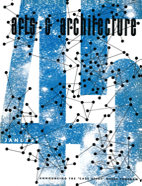The 1950s, Part 1:
Learning Architecture in the US
"As I look back [on my education at Cornell], it was, in the absence of any rigorous instruction, a very beneficial learning situation, since it forced us to carefully, and penetratingly, involve ourselves with [Mies's and Wright's] work.3 It was also the time of John Entenza's Arts and Architecture Magazine and the Case Study Houses, though of even greater interest for us was the magazine Spazio edited by Luigi Moretti, and especially the famous article on architectural space." Werner Seligmann AIA/ACSA 1998 Topaz Medallion Acceptance Speech4
Both Walter Gropius and Ludwig Mies van der Rohe settled in the US from Germany in the late 1930s. Slowly, one began to see architectural projects coming from the academies—and eventually on some professional drawing boards (mostly modest commercial and residential projects), then publication, then more schools of architecture—that appeared much more sleek and chic than those generated by the Beaux-Arts models that had dominated American architectural education. These projects were better adapted to America's progressive self-image, shaped by the acute optimism of the post-WWII years. Though the European origins of the Bauhaus ideal, in its teaching, programming, and social objectives, can be seen as having been infused with a certain Marxist social ethic, it was clearly hybridized for American capitalist consumption once it crossed the water. However, absent the rigorous interdisciplinarity of the workshop structure, much of what was transmitted to this new academic audience was limited to the imagery: unfussy boxes often representing the expression of various functions, lots of articulated frames, and exposed beams from time to time (thanks, perhaps, to Marcel Breuer's directorship of the carpentry shop at the Bauhaus).
By the 1950s, when Werner Seligmann was in college, most schools saw these Bauhaus-inflected representations redecorating curricula that were still essentially served up via the Beaux-Arts academic method. But it was in many ways a spiritless rendition of the earlier optimism of the foundational movements. Perhaps because it was a modernism necessarily adapted to the requirements of post-war economies: mass-produced suburban housing, increased industrialization, expanding infrastructure, more public schools, and so on.
Significantly, during his school years, Seligmann seems to have found a part of his inspiration in two publications that had modest circulation in the U.S.: Arts & Architecture (originally California Arts & Architecture), which was at its peak from the mid-1940s until 1967, and the Italian magazine Spazio, published from 1950 until 1953, with a few special issues published from time to time into the 1960s.
Beginning around 1938, editor John Entenza slowly transformed Arts & Architecture from a journal featuring the historic revivalism of mansion design in California, to a position that was a clear contrast to the more commercial, trade-oriented East Coast architectural magazines that dominated the market in architectural journalism. He saw the single family house as modern architecture's best chance at winning over middle-class America. Because, in Entenza's view, contemporary architecture was seen as a confluence of numerous developments in the arts, each issue of Arts & Architecture contained historical and theoretical essays on music and the visual arts—including film, painting, and sculpture—with occasional essays on social and political theories. Historical features, such as on Mayan art, were included because of their potential for supporting modernist esthetic principles: a degree of apparent abstraction, details limited to their essentials, and forms capable of reflecting the (presumed) values of their cultures.
Introduction page 2

Fig 1 Cover, Arts & Architecture, January 1945, with announcement of Case Study House program; cover design by Herbert Matter